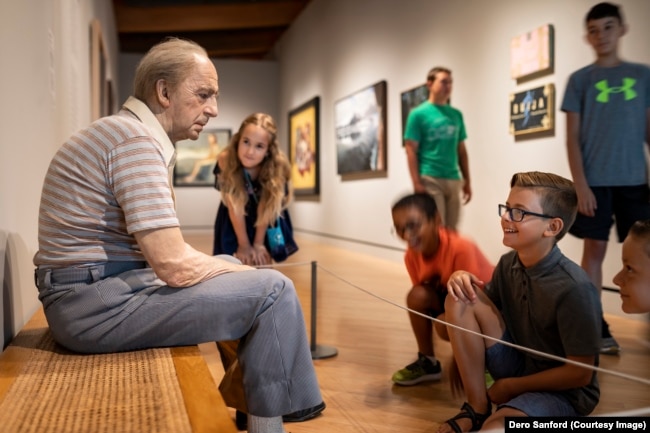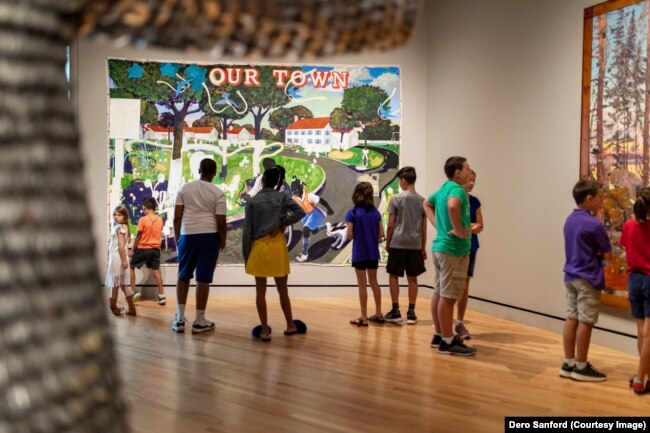Trips to museums are part of many children’s education in the United States. The American Alliance of Museums says museums receive about 55 million visits each year from students in school groups.
Many U.S. school systems are most concerned about students performing well on required math and science tests. Because of this, administrators and teachers might not see the value of art-related museum field trips.
This is where Jay Greene comes in. He is a professor of education policy at the University of Arkansas. He and his research team are studying how attending cultural events help a student’s education. The National Endowment for the Arts supports part of their research.
Greene told VOA that his team wanted to learn how a single trip to an art museum affects a student. For this study, he and his team looked at 11,000 students.
“...And we found that students who visited an art museum were more tolerant, more empathetic, and also learned a lot of content about the art they saw and developed stronger critical thinking skills about art.”

School children look at art at the Crystal Bridges Museum of American Art, Bentonville, Arkansas
Greene explained that after one visit to the art museum, students averaged an eight percentile improvement on tolerance and empathy. He calls that a “moderate effect,” but “impressive,” considering that it was after just one visit to the art museum.
Marissa Reyes is with Crystal Bridges Museum of American Art in Bentonville, Arkansas. The museum has been involved with Greene’s studies. Since 2012, the museum has had nearly 300,000 students come to visit. It also sends teaching artists to local classrooms.
Reyes said she agrees with Greene’s findings on the effects of museum trips. She added that the greatest effect appears to be for students in rural areas, minority students and those who attend high-poverty schools.
Greene’s researchers also examined how going to a live theater performance can affect students. This study involved a small number of subjects – about 1,500 students from 40 schools. The students were also older. They all lived in northwest Arkansas.
Green said his team found that students who saw a live performance “experienced improvement in tolerance and empathy.”
A different group of students watched a movie version of the same play. Greene said they did not experience the same results as those who went to the live theater. The students who saw the live performance learned the story and related vocabulary better than those who watched the movie version, he said.
“So we think that there's something special about in-person cultural experiences that are different than simply digital experiences of those of those same stories.”

School children look at art at the Crystal bridges Museum of American Art, Bentonville, Arkansas
Greene’s team is now carrying out longer-term studies, in which they are following students over many years. He has already seen some promising results among students who have been visiting the Woodruff Arts Center in Atlanta, Georgia.
“Our most surprising result is that we saw improvements in math and reading test score performance for students in Atlanta after they went on multiple enriching field trips. We think that again that has to do with improving their motivation.”
Greene says that the fact they did well on the tests “suggests that motivation is a very important part of success in school.” This is true for students of all ages.
Students’ behavior in school also improved. Greene thinks part of that may be because they were doing something fun in school.
“Because if the school doesn't do it for kids from more disadvantaged backgrounds, then it's possible these kids won't get much exposure to the arts at all.”
And that, he says, may hurt their future.
Combining the arts and STEM fields
Some museums, like Crystal Bridges Museum in Arkansas, are looking for ways to offer new programs for schools.
Marissa Reyes said that, in addition to their usual arts field trips, the museum also offers “STEM-based tours.” STEM stands for science, technology, engineering and math—areas of great concern to many schools. Reyes explained that these tours look at connections “between art and science, art and math, and art and architecture.”
She said, “these experiences complement learning goals in both the arts and the STEM categories."
I’m Anne Ball.
Q: What do you think of this story? Do you like to go to the art museums in your city?